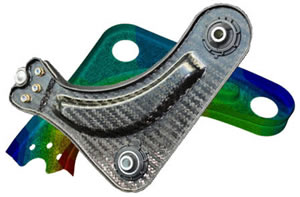The two Carnot Institutes have joined forces to produce – together with the SME Compose – a fully composite automotive wishbone suspension. The innovation lies in the possibility of producing light parts with high mechanical performance, at rates compatible with the requirements of automobile production. PSA Peugeot Citroën is a partner.
ONERA and Cetim (Centre Technique de l’Industrie Mécanique) are two Carnot Institutes. They have worked together to design and manufacture a fully composite automotive wishbone suspension, according to production requirements specific to the automotive industry.
The first part prototype was made by Cetim, with the assistance of the SME Compose, from thermoplastic sheets reinforced with thermoformed carbon fibers and welded together. The mechanical and functional characteristics are identical to those of the mechanical part to be replaced, with a mass of 2 kg instead of 3.200 kg in total.

This wishbone suspension foretells a composite future for cars and generalizability for aeronautics.
In the background, the part designed digitally by ONERA.
In the foreground, the operational part manufactured by Cetim and Compose.
The real innovation of this partnership stems directly from the strengths of the two Carnot institutes: for Onera, skill in designing composite parts (in particular numerical modeling and experimental characterization); for Cetim, technological aspects and process control. Thus, Onera designed the wishbone suspension using its numerical methods that were developed for aerospace, according to the requirements of a set of automotive specifications provided by PSA Peugeot Citroën. Cetim developed a high rate production line, consistent with automobile production requirements, relying on Compose, which made an innovating mold for the part.
At the scale of a complete vehicle, the gains in terms of weight reduction will be significant and will notably lead to a reduction in consumption and the use of alternative energy sources.
This democratization of high level aerospace technology to the automotive industry will in return benefit the aeronautical manufacturers and suppliers, which may have large batches to manufacture (for example seats, which contain disadvantageous metal parts).
This successful aero/auto skill sharing experience advocates the creation of a "composite" cross-sector, because the pooling of complementary skills would lead to considerable potential gain in performance and productivity.
Contact Onera : Christian.Fagiano \@/ onera.fr




